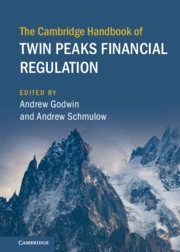Book contents
- The Cambridge Handbook of Twin Peaks Financial Regulation
- The Cambridge Handbook of Twin Peaks Financial Regulation
- Copyright page
- Contents
- Figures
- Tables
- Contributors
- Foreword
- Acknowledgements
- 1 Introduction
- Part I Surveying the Terrain
- Part II The Trek towards Twin Peaks
- Part III Different Topographies
- 10 Can the Twin Peaks Model of Financial Regulation Serve as a Model for Israel?
- 11 Towards a Twin Peak Regulatory Architecture for Hong Kong?
- 12 Regulatory Structure and the Revolving Door Phenomenon in South Korea
- 13 China
- 14 Financial Regulatory Structure in China
- 15 US Financial Regulatory Structure
- 16 A ‘Twin Peaks’ Vision for Europe
- 17 A Complex European Financial Architecture
- Part IV Seismic Activity and Fault Lines
11 - Towards a Twin Peak Regulatory Architecture for Hong Kong?
from Part III - Different Topographies
Published online by Cambridge University Press: 24 June 2021
- The Cambridge Handbook of Twin Peaks Financial Regulation
- The Cambridge Handbook of Twin Peaks Financial Regulation
- Copyright page
- Contents
- Figures
- Tables
- Contributors
- Foreword
- Acknowledgements
- 1 Introduction
- Part I Surveying the Terrain
- Part II The Trek towards Twin Peaks
- Part III Different Topographies
- 10 Can the Twin Peaks Model of Financial Regulation Serve as a Model for Israel?
- 11 Towards a Twin Peak Regulatory Architecture for Hong Kong?
- 12 Regulatory Structure and the Revolving Door Phenomenon in South Korea
- 13 China
- 14 Financial Regulatory Structure in China
- 15 US Financial Regulatory Structure
- 16 A ‘Twin Peaks’ Vision for Europe
- 17 A Complex European Financial Architecture
- Part IV Seismic Activity and Fault Lines
Summary
This chapter argues that a Twin Peaks model designed around financial stability and market conduct regulators supervising all financial sectors would overcome the sectoral model’s limitations. This regulatory change supports the evolution and competitiveness of Hong Kong as an international centre for finance and technology. The proposed reform agenda concludes that technological developments, cost-effective and proportionate regulatory reforms, and a modern regulatory architectural design for setting internationally recognised standards of smart regulation enabled by regulatory technology or RegTech must be the path forward.
- Type
- Chapter
- Information
- The Cambridge Handbook of Twin Peaks Financial Regulation , pp. 191 - 214Publisher: Cambridge University PressPrint publication year: 2021

